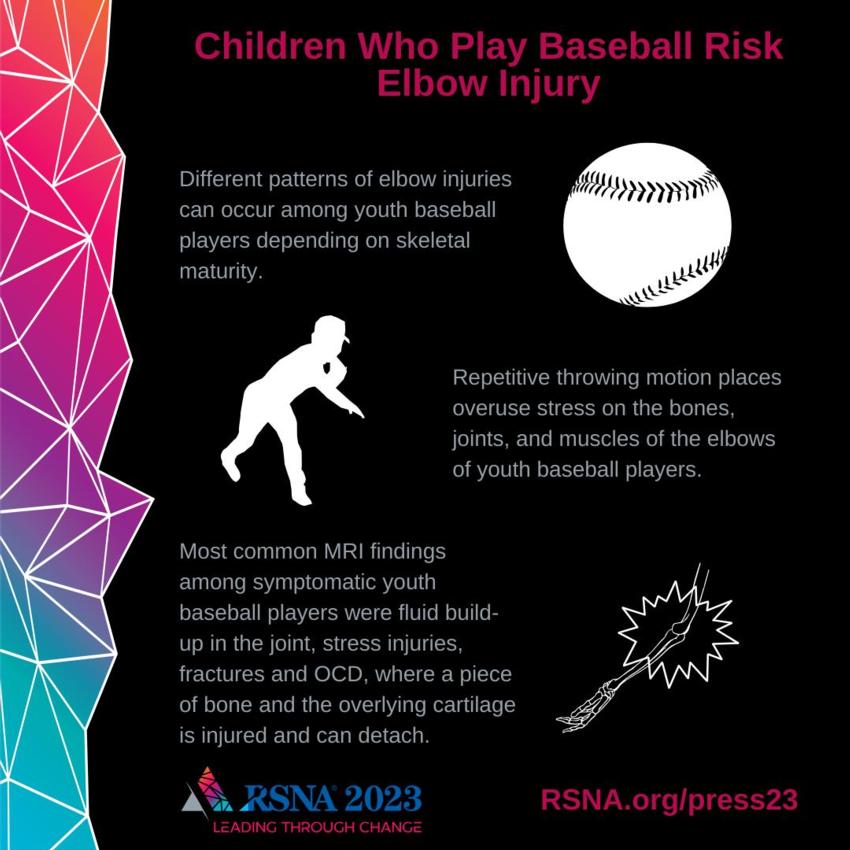Children Who Play Baseball Risk Elbow Injury
Released: November 30, 2023
At A Glance
- Different patterns of elbow injuries can occur among youth baseball players depending on skeletal maturity.
- Repetitive throwing motion places overuse stress on the bones, joints, and muscles of the elbows of youth baseball players.
- Most common MRI findings among symptomatic youth baseball players were fluid build-up in the joint, stress injuries, fractures and OCD, where a piece of bone and the overlying cartilage is injured and can detach.
- RSNA Media Relations
1-630-590-7762
media@rsna.org - Linda Brooks
1-630-590-7738
lbrooks@rsna.org - Imani Harris
1-630-481-1009
iharris@rsna.org
CHICAGO — Youth baseball players are prone to elbow pain and injuries, including repetitive overuse changes and fractures, based on the maturity of their bones, according to a new study being presented today at the annual meeting of the Radiological Society of North America (RSNA).
The repetitive motion and force of throwing a baseball places a large amount of stress on the growing bones, joints and muscles of the elbows of baseball players. Youth baseball players who have not yet reached skeletal maturity might be especially vulnerable to elbow pain and injuries.
“When we look at the forces that baseball players, even Little League baseball players, deal with during routine practice and games, it becomes apparent why elbow injuries are so common amongst this group,” said study co-author Vandan Patel, B.S., a radiology-orthopedics research scholar at Children’s Hospital of Philadelphia (CHOP) in Pennsylvania.
Most recent estimates show that 20 to 40% of youth baseball players between the ages of nine and 12 complain of elbow pain at least once during the season.
Skeletally immature children have growth plates, which are areas of bone that are made up of cartilage, a rubbery and flexible connective tissue, that allows the bones to grow and change in shape as a child ages. Growth plates are weaker than the surrounding muscles and bones and prone to injury that can lead to either reversible changes or permanent deformity.
Skeletal maturity occurs when the growth plates have closed, and no more bone (or growth) is being made. This usually occurs at the end of puberty, typically around age 13 to 15 for girls and 15 to 17 for boys.
In this retrospective study, the researchers reviewed elbow MRI exams from 130 youth players (18 years of age and younger) being evaluated for elbow pain. MRI is an ideal method for identifying joint problems, because it can non-invasively show cross-sectional details of soft tissues (cartilage, tendons and ligaments) and bone.
“We conducted this study in order to better understand the patterns of injuries that can occur among youth baseball players with elbow pain,” said senior author Jie C. Nguyen, M.D., M.S., director for the Section of Musculoskeletal Imaging in the Department of Radiology at CHOP. “Tissue vulnerability and, thus, sites at risk for injury, change with growth and maturation. A younger player injures differently than an older player. It is our hope that this data will help us continue to improve and individualize the care of current and future generations of youth baseball players.”
The average age of this study group of patients was 13.9 years, with 115 boys and 15 girls included. The frequency with which the patients played baseball varied from daily to recreationally.
Two radiologists independently reviewed the MRI exams to categorize the skeletal maturity and different findings of each patient’s elbow. They classified 85 patients as skeletally mature and 45 patients as skeletally immature.
The most common MRI findings in skeletally immature players included fluid build-up around the joint, stress injuries near the growth plate, fractures, and osteochondritis dissecans (OCD) lesions, where a piece of bone and the overlying cartilage is injured and can detach, leading to reduced range of motion and risk for premature osteoarthritis in adulthood.
Conversely, in skeletally mature players, the injury pattern shifts from the growth plates to the soft tissue. These players most often had triceps tendinosis—a condition in which the tendon connecting the triceps muscle to the elbow bone becomes strained, irritated or torn—and fluid build-up in the bony area of the elbow where the ulnar collateral ligament attaches. The ulnar collateral ligament runs on the inner side of the elbow and helps stabilize it.
Injuries that required surgery included intra-articular bodies (small fragments inside the joint), and unstable OCD.
“In terms of the skeletally immature children, 9 patients (11%) had intra-articular bodies, and 19 patients (22%) had OCD lesions,” Patel said.
The researchers hope that the results of this study will help to identify elbow injuries in children who play baseball and to individualize treatment based on skeletal maturity.
“This information is critically important not only to physicians, but also to parents and team coaches, all of whom provide crucial support for these children, reducing injury and preventing permanent damage on and off the field,” said co-author Theodore J. Ganley, M.D., director of Sports Medicine and Performance Center in the Division of Orthopaedics at CHOP. “As parents, caregivers and coaches, it is important to be aware of these findings in order to ensure that symptoms of pain are not overlooked during the baseball season.”
Although they did find that prevalence of injury was linked to prolonged play, the researchers said further studies are needed to identify exactly which injuries are more time dependent compared to others.
“This does not mean that elbow injuries are inevitable in baseball,” Patel said. “With proper technique and proper rest, these injuries could potentially be avoided.”
Additional co-authors are Shahwar M. Tariq, B.S., Liya Gendler, D.O., Apurva S. Shah, M.D., M.B.A., and Adam C. Zoga, M.D., M.B.A.
Note: Copies of RSNA 2023 news releases and electronic images will be available online at RSNA.org/press23.
RSNA is an association of radiologists, radiation oncologists, medical physicists and related scientists promoting excellence in patient care and health care delivery through education, research and technologic innovation. The Society is based in Oak Brook, Illinois. (RSNA.org)
Editor’s note: The data in these releases may differ from those in the published abstract and those actually presented at the meeting, as researchers continue to update their data right up until the meeting. To ensure you are using the most up-to-date information, please call the RSNA Newsroom at 1-312-791-6610.
For patient-friendly information on pediatric and musculoskeletal imaging, visit RadiologyInfo.org.
Video (MP4):
Images (JPG, TIF):

Figure 1. Elbow images. In image on the left (10-year-old boy), growth plate has not yet fused. On the right (15-year-old boy), growth plate has fused. (Courtesy of Radiology)
High-res (TIF) version
(Right-click and Save As)

Figure 2. Elbow injury in 12-year-old boy. (Courtesy of Radiology)
High-res (TIF) version
(Right-click and Save As)

Figure 3. Sketch of developing elbow, before and after growth plate closure. (Courtesy of Radiology)
High-res (TIF) version
(Right-click and Save As)

Figure 4. MRI findings in elbow among pediatric baseball players and with respect to regional skeletal maturity.
High-res (TIF) version
(Right-click and Save As)
Additional Resources




